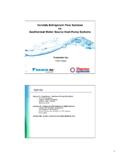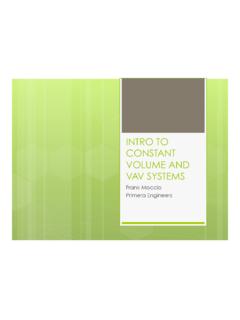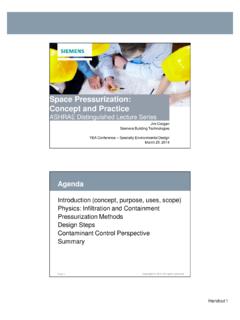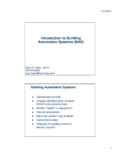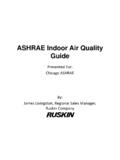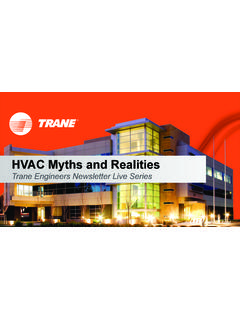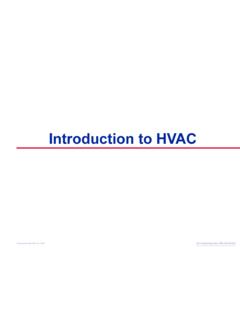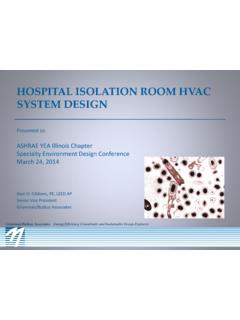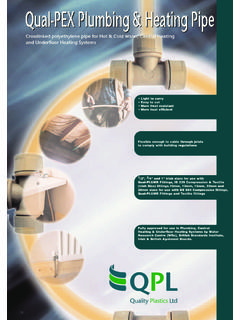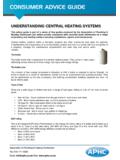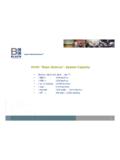Transcription of Basics of Room Air Distribution - ASHRAE® Illinois …
1 Basics of room Air Distribution Dan Int-Hout Chief Engineer / Krueger Richardson Texas 3/22/2011. Study Objectives Main issues of thermal comfort Principles of air Distribution as they relate to human comfort Principles of space air Distribution Functions of the different types of air Distribution devices 2. Where We Are Today: Occupant Comfort Thermal Interchange Between People and Environment 5. Temperature and Humidity Comfort Zone Dry-bulb temperature, F. Relative humidity, rh Thermal radiation Air movement, fpm Insulation value of clothing, clo Activity level, met Direct contact with surfaces not at body temperature 6. ASHRAE Standard 55-2004. Thermal Environmental Conditions for Human Occupancy 7. For 80% Thermal Acceptance Activity levels are between 1 and met. Clothing is near or 1 clo.
2 Average Air speeds are below 40 fpm. 8. 9. Avoid in humid climate to avoid mold 10. Ideal target conditions 11. Low humidity a health issue 12. Graphical Solution Program Thermal Comfort ASHRAE Standard 55-2010 mandates a maximum F vertical temperature stratification in Occupied Zone Velocities within the occupied zone shall be 50 FPM. 2' 2'. Floor to Occupants' Head Level ( ft. for seated, 6 ft. for standing occupants). Comfort Economics ASHRAE Journal, June 2008. LEED 09 ASHRAE Std 55 Checklist Indoor Air Quality Indoor Air Quality Standing Standard Project Committee Residential Committee is Current Standard is '13. Several addenda for the '13 version have already been approved, and will be published in a compiled addenda, every 18 months (or so). air in which there are no known contaminants at harmful concentrations as determined by cognizant authorities and with which a substantial majority (80% or more) of the people exposed do not express dissatisfaction.
3 19. Two Compliance Paths: Ventilation rate procedure Prescribed rates in Table 6-1 : cfm/person plus cfm/square foot Office: 5 cfm/person plus cfm/ft2. Default = 17 cfm / person in an office Only cfm/person in Hotel multi purpose space Indoor air quality (IAQ) procedure 20. IAQ Standard Standard 62 is on continuous maintenance. Continuous and incremental changes are in progress. It will attempt to be in coordination with building codes. A Guideline document for designing systems above minimum requirements is being created. Users Manual is available now. The IMC has referenced in the 09 release of the mechanical code. There seems to be minimal public awareness of the dynamic nature of the Standard. Acoustics Acoustics: AHRI 885-08 acoustical application standard. AHRI 880-08 air terminal test standard.
4 AHRI 260-01 ducted equipment except air terminals. ASHRAE 70, air diffuser performance. Acoustical quality suggests the use of RC (or newer measures) rather than NC. Many acousticians are heading back to dBA! LEED V4 includes acoustical credits and requirements, and references AHRI 885. A new ruling by AHRI will change everyone's discharge sound ratings considerably. End Reflection Low frequency sound traveling down a duct will partially reflect back when encountering a rapid change in area. The smaller the duct, the greater the effect. It can be as much as 10dB at 125Hz. It is much less at higher frequencies. Since NC is usually set at 125Hz, reported NC. can go up as much as 10NC. Most importantly, Specifying Engineers should be modifying their discharge sound requirements to reflect the new data.
5 End Reflection Sound Specifications Should be based on clearly stated assumptions. Should reflect real project needs, not any manufacturer's data and use currently accepted application If duct lining is used require: NC shall be determined in accordance with AHRI 885-08, Appendix E , otherwise specify octave band sound power. Specifications need to be modified to account for the new reported data. Over-silencing increases both initial costs and operating costs, and may hinder proper IAQ. performance. Air Distribution Principles Outlet Types Grille: movable or fixed blades to direct the air and adjust width of jet. Works well in floor, sill and wall. Slot diffuser: long, narrow slot producing rapid diffusion; use a grille for the ceiling. Ceiling diffuser: rings of pressed metal to supply air across the ceiling.
6 28. Outlet Accessories Dampers: opposed blades adjust flow while parallel blades also adjust direction. Be careful of significant flow adjustment at damper due to noise. Quieter, less noticeable air noise, when flow is adjusted at branch. Directional vanes to collect or direct airflow. 29. Outlet Selection Understand the space, esthetics, and air supply access. Determine quantity of air to be supplied. Select type: air quantity, throw, obstructions in the space, and architecture. Locate outlets for uniform Distribution . Select proper size. 30. Return or Exhaust Inlets Any style of outlet. Free area for air transfer is required. No effect on general flow around the space. Position so primary air is not collected. Good in stagnant zone. 31. Understanding The Terminology Primary Air Jets - Air jets from free round openings, grilles, perforated panels, ceiling diffusers and other outlets can be defined by three variables.
7 Throw Drop Spread Understanding The Terminology THROW. DROP. Understanding The Terminology Spread - is defined as the divergence of the airstream in a horizontal or vertical plane after it leaves the outlet. 50 fpm Typical 100 fpm 150 fpm Understanding The Terminology Coanda Effect - a negative or low pressure area is created between the moving air mass and the ceiling at or near the supply air outlet. This low pressure area causes the moving air mass to cling to and flow close to the ceiling surface and increases the throw. Coanda Effect Understanding The Terminology Understanding primary air jet variables enables Accurate prediction of room air flow Improvement of thermal comfort Proper selection of grilles, registers and diffusers Adherence with ASHRAE Ventilation Std as a Leed PREREQUISITE, and in the 2009 IMC.
8 Understanding The Terminology The Basis of Catalog Performance Data Throw The horizontal or vertical axial distance an airstream travels after leaving an air outlet, usually assumes a surface adjacent to the air outlet Pressure Can be total pressure or static pressure Sound Can be either NC or Octave Band data Throw Throws are cataloged for 150, 100 and 50 fpm terminal velocities. Throws should be selected so that jets do not collide, but have sufficient projection for the area to be served. 150fpm 100fpm 50fpm 7 8 12. Pressure PS. PT. Pressure Air outlet pressure data is required to properly size the air delivery system within a building. Static Pressure The outward force of air within a duct, measured in inches of water column. Velocity Pressure The forward moving force of air within a duct, measured in inches of water column.
9 PS. PT. Total Pressure The sum of the velocity and static pressures, expressed in inches of water column and can be obtained by use of a pitot tube. PT = PV + PS. Sound Sound levels reported for diffusers are conducted in accordance with ASHRAE Standard 70. Catalog sound data assumes 10 diameters of straight duct. room absorption is assumed to be 10dB in all bands. In practice however, room sound levels are probably 5 NC higher than reported. Air Distribution , Poor Pattern Air Distribution , Good Pattern Understanding ADPI. ADPI. ADPI is the percentage of points within the occupied zone having a range of effective draft temperatures of -3 to +2 of average room temperature at a coincident air velocity less than 70 FPM. ADPI is essentially a measure of the degree of mixing in zones served by overhead cooling systems.
10 When air Distribution is designed with a minimum ADPI of 80% the probability of vertical temperature stratification or horizontal temperature non-uniformity is low and conformance with ASHRAE Standard 55 (Thermal Comfort). requirements is high. ADPI does not apply to heating situations or ventilation- related mixing. ASHRAE Fundamentals Chapter 20, Table 3. ADPI selection using T50 / L. was developed in the 60s where L is the distance to the nearest wall or halfway to the nearest air A relationship was found between 50 FPM/min isothermal throw and cooling throw, Using this table engineers can assure clients that diffuser selections will provide acceptable mixing and air change effectiveness. Perforated 24X24, 10 inlet, 4 way, 20 Delta-T. Spacing for 80% ADPI. 16. 14 CFM. NC=35. 1/2 Unit Separation Distance 12.

